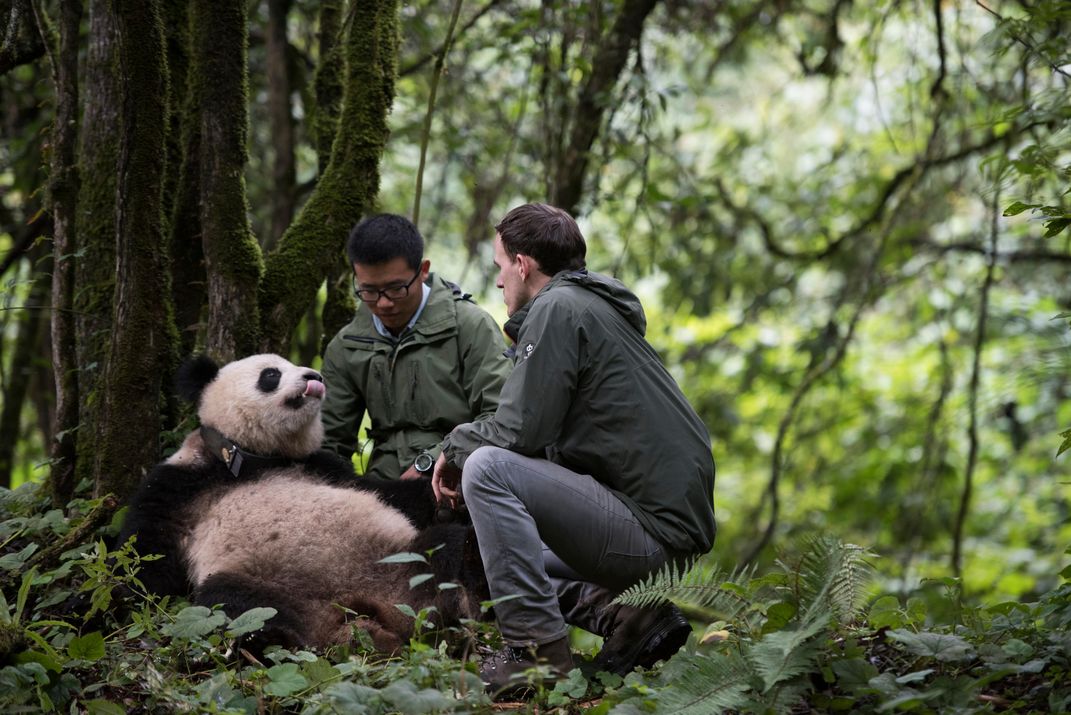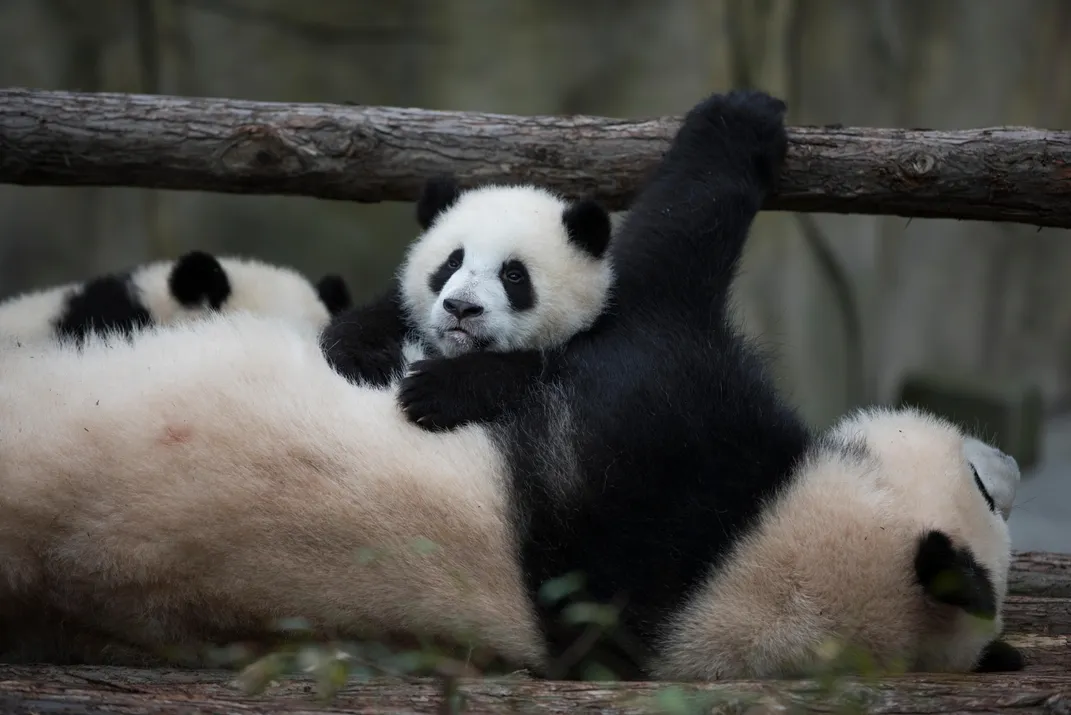The Science Behind the Unbearably Cute IMAX Movie “Pandas”
Wild populations of these loveable fuzz-faced bears need help, and scientists are on the case
:focal(2643x1029:2644x1030)/https://tf-cmsv2-smithsonianmag-media.s3.amazonaws.com/filer/62/76/6276bcd2-3d39-42ef-bb74-b9047906ec9f/rev-1-pds-00569_high_res_jpeg.jpeg)
There's something irresistible about a baby panda. Perhaps it's the waddling walk, the chubbiness of their cheeks or extra fuzz around their face. Or maybe it's their love of climbing, which often ends in a fall—or a faceplant. Whatever it is, their squeaks and coos never fail to elicit a squeal of delight from onlookers.
But there's more to pandas than their amusing antics. Behind those soulful black eye patches is a species that has spent decades clawing its way back from near extinction in the wild. For more than ten years, researchers have attempted to bolster these wild populations by releasing captive creatures. Now, a new IMAX documentary, Pandas, chronicles the daunting—but adorable—journey of one panda as she finds the wild within.
Co-directed by David Douglas and Drew Fellman, the film follows Qian Qian (pronounced Chen Chen), who was selected from group of roly poly baby pandas for her stubborn streak of independence and affectionate nature. The new film, now on view in two Smithsonian Theaters, is a visual treat with sweeping views of the forested mountain region in China’s Sichuan province, where some of the world’s last populations of wild giant pandas chomp bamboo, clinging to life in the face of encroaching human development. Qian Qian’s story, narrated by Kristen Bell, is panda plentiful and optimized for maximum family-friendly visual enjoyment.
The film follows the work of Jake Owens, a wildlife biologist at the Chengdu Research Base of Giant Panda Breeding in China, and his Chinese colleague Bi Wen Lei, who were tasked with the enviable job of raising Qian Qian and preparing her for a wild adventure.
Native to the rugged mountains of central China, the pandas have become a symbol of conservation around the world. In the late 1900's, poaching, deforestation and encroaching human development devastated the loveable beasts' populations. Since that time, however, with strong support of the Chinese government, populations seem to be slowly recovering.
But they're not out of the woods yet. Today, the roughly 2,000 that exist in the wild live largely in small, fragmented populations that are separated by crosscutting roads. From 1976 to 2001, the average size of bamboo forest patch—the panda's preferred habitat—shrunk by around 24 percent, only recovering by 1.8 percent in the years since. The isolated slivers of habitat limit the panda's gene pool and opportunities to breed. There is hope, however, recently the Bank of China pledged billions of dollars to support the creation of an unbroken panda park more than twice the size of Yellowstone.
The release into the wild of captive creatures could also eventually help to minimize these troubles, explains Melissa Songer, a Smithsonian conservation biologist. Over the last several decades, researchers have made leaps and bounds in the science of breeding captive populations. "They've totally nailed the breeding,” says Songer, who is an expert in restoring species and ecosystems at the Smithsonian’s Conservation Ecology Center. "They can make piles of pandas every year if they want." But, she adds, "there are only so many zoos that can take those pandas." The next step is rewilding.

Since 2006, the Chinese government has been reintroducing captive pandas to the wild, with mixed success. Of the seven who have been released, five have survived. Qian Qian was one of two pandas selected for the inaugural test of a new reintroduction method, developed as a collaboration between the non-profit Global Cause Foundation and the Chengdu Research Base of Giant Panda Breeding in Sichuan province.
Past breeding attempts were based on the idea that by minimizing contact with their human keepers, the captive creatures don't habituate to their strange hairless helpers. Researchers at the Wolong Nature Reserve in Sichuan Province, wear black and white panda suits treated with panda poop and pee so that they looked—and smelled—like their tiny charges.
But the new method takes the opposite approach, where the human element is key.
"We're not trying to avoid the human contact," Owens says. "We're using human interactions as an advantage." By earning the pandas' trust, Owens and Bi Wen Lei are more easily able to monitor Qian Qian and another panda He Sheng, who was not in the film, to guide the pair as they learn to survive in the wild.
The method was adapted from the work of the New England-based naturalist Ben Kilham who works tirelessly to raise and reintroduce orphaned black bears to the forests of New Hampshire. Kilham—also known as "papa bear"—and his sister Phoebe have been working with cubs since the 1990s, and have released more than 160 bears back into their natural habitat.
Drew Fellman, the co-director, producer and writer of the new film, learned of Kilham's work with black bears almost a decade ago. The pudgy bears beguiled him. "I just kept wanting to go visit these bears and buy him dinner," he says. During one of these visits, Kilham mentioned a new collaboration with the Chengdu panda researchers. Hou Rong, the director of the Chengdu Research Base for Giant Panda Breeding, visited Kilham's farm and had decided to incorporate his expertise to launch the pioneering new rewilding program.
"That was like 'boom,'" Fellman says. He couldn't wait to get started.

Born in 2013, Qian Qian began her training with Owens and Bi Wen Lei at just six months old, learning to trust her human playmates. He Sheng was similarly trained. As part of building this relationship, Owens explains, the trainers don't force or initiate interactions, instead they followed the cues from the animals.
"We let the pandas do what the pandas want to do," Owens explains. "If they want to go on a walk, we go on a walk. If they want to come up and grab us and pull our pants and whatever, that's cool." Throughout this period, the pandas are moved through a chain of increasingly larger and more wild-like enclosures, learning along the way to stay more alert to possible threats, to climb trees and to forage for their favorite choice of food, bamboo. "We can't teach the pandas," says Owens. "We give them these conditions and let their natural instincts come out."
In the summer of 2016, equipped with GPS tracking collars and IMAX cameras at the ready, Qian Qian and He Sheng took their first lumbering steps into the wild.
It was a triumphant moment.
But the tale soon took a heart wrenching turn when Qian Qian's tracking collar alerted researchers she hadn't moved in 24 hours. The team immediately responded, trekking through the dense forests to locate the injured bear. They found her draped in a tree, severely dehydrated with an infected paw. It took days of nourishment and coaxing to convince her to climb back down.
The new film captures the dramatic search and rescue in edge-of-seat drama and detail. Though it's heart wrenching to watch the film’s fuzzy heroine in trouble, Owens says the ordeal has helped her become more cautious—an important trait for wild survival. "Any weird sounds or abnormal sounds, she flees," he says. "That's how she is now, and that's how she should be." What's more, their successful capture, says Songer, hints that the years of effort earning panda trust were worth it.

As for the other panda, in September of 2016, just two months after the release of the pair, He Sheng was found dead with bite wounds from an unknown animal to his shoulder, ear and leg.
When asked if this loss was cause for concern about the program, Songer was quick to respond, "no." She explains: "It's a very risky thing to do, to take a captive animal whether it's a panda or [any other creature]. That's part of the risk you're taking on." But if the pandas can survive and mate, it's worth the risk.
The hope is that future releases will be more than one or two creatures, says Songer. The more pandas that are released, the bigger impact it will have on communities.
For now, Qian Qian is ambling about in a wild-like enclosure. But researchers hope she will soon again waddle completely free in the wild. Owens is optimistic about the program's future. "I wouldn't be in China for four years, plus doing this, if I didn't think it really had a conservation benefit, and it was going to lead to the long-term success of giant pandas," he says. "Hopefully, we'll get there pretty quickly."
"It's a decades-long effort," Fellman adds. "We're looking at the very beginning of it."
Pandas 3D is on view through October 2018 at the Smithsonian Theaters at the National Air and Space Museum on the National Mall in Washington, D.C. and at the museum’s Udvar-Hazy Center in Chantilly, Virginia.
/https://tf-cmsv2-smithsonianmag-media.s3.amazonaws.com/accounts/headshot/Wei-Haas_Maya_Headshot-v2.png)


/https://tf-cmsv2-smithsonianmag-media.s3.amazonaws.com/accounts/headshot/Wei-Haas_Maya_Headshot-v2.png)